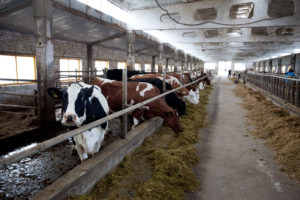Declining Number of Farms in South Korea

South Korea has been facing serious problems in agriculture in recent years. The sector, which was once the backbone of the country's economy, now accounts for only 1.6% of the country's gross domestic product (GDP). According to the statistical service, the number of farms has decreased by more than 12% in 2022, and this trend is continuing to accelerate. The reasons for this phenomenon are multifaceted and require careful analysis.
Demographic crisis
One of the main reasons for the decline in the number of farms is the demographic crisis. Last year, more than half of the country's 228 small towns and counties were at risk of disappearing, due to a decrease in population. Young people are flocking to megacities, where educational and career opportunities are concentrated. Large cities such as Seoul are home to elite universities and prestigious companies, making rural life less attractive.
Financial aspects
The average income of rural workers is only 60% of that of their urban counterparts. This creates a significant economic gap that is pushing young people away from the rural lifestyle. The rural population, which accounts for about 5% of the country's active population, is becoming increasingly old. According to Statistics Korea, about two million residents are engaged in agriculture, and most of them are elderly.
Government measures
To cope with this situation, the South Korean government is taking a number of measures aimed at stimulating young people to move to villages. One such step is financial incentives, which can reach $300,000 per person. These funds are intended to support young people in obtaining education in agricultural specialties, as well as for the repair and construction of housing.
However, despite these initiatives, the results are not impressive so far. Villages continue to die out, and many of the proposed programs do not resonate with young people. The reasons for this are not only financial aspects, but also insufficient infrastructure and limited career opportunities in rural areas.
Alternative approaches
Some experts suggest alternative approaches to solving the problem. For example, the development of agrotourism can be one of the ways to attract young people to villages. Providing recreational and leisure facilities, as well as opportunities to gain work experience in agriculture, can make life in the countryside more attractive.
In addition, the introduction of modern technologies into agriculture, such as automation and the use of drones, can improve efficiency and reduce the physical strain on farmers. This can attract young people interested in high technology and innovation.
The situation in South Korea's agriculture requires a comprehensive approach and active participation from both the state and society. Attracting young people to rural areas is not only a matter of economic sustainability, but also the preservation of the country's cultural heritage. If the government and society can find effective solutions, it may be possible to not only preserve but also revitalize rural areas in SOUTH KOREA.
Read together with it:
- UniCredit заявил о галактических усилиях из-за санкций против РоссииUniCredit старается не нарушить «более 15 тыс. санкций», а также не «совершать ошибки», которые позволят изъять его активы в России, заявил гендиректор. После начала военной операции банк начал рассматривать возможность ухода Итальянский банк UniCredit прилагает «галактические усилия», пытаясь соблюсти международные санкции в отношении своего российского подразделения. Об этом заявил генеральный д...
- Зеленский ввел санкции против своего бизнес-партнераМиндич и Александр Цукерман, который, как считается, отвечает за его финансовые вопросы, значатся как граждане Израиля. Санкции против них ввели на три года, они включают блокировку активов. На Украине сочли ограничения мягкими Владимир Зеленский Президент Украины Владимир Зеленский подписал указ о введении санкций в отношении совладельца студии «Квартал 95» Тимура Миндича и его знакомого бизнесме...
- При наезде грузовика на рынке в Республике Корея погибли 2 человека, 18 пострадалиФото en.yna.co.kr 13 ноября, Минск. По меньшей мере 2 человека погибли, еще 18 получили ранения в результате наезда грузовика на рынке в Пучхоне в Республике Корея, сообщает агентство Yonhap со ссылкой на официальных лиц.По данным полиции, трагедия произошла около 11 утра по местному времени. Грузовик наехал на людей в пространстве между торговыми рядами. Водитель грузовика был задержан на месте п...
- Китай рассматривает возможность введения пошлин на аргентинскую говядинуВ преддверии открытия новой Китайской международной импортной выставки (CIIE), одного из важнейших торговых мероприятий в мире, возникла проблема, затрагивающая всю цепочку поставок скота и мяса из Аргентины: китайское правительство ввело «защитную» процедуру в отношении импорта говядины. Эта мера, вступившая в силу в декабре 2......
- Увеличение спроса на американскую свинину и говядину в Корее: результаты ознакомительной поездки фермеровКорея занимает ведущее место среди стран-импортёров американского мяса. На сегодняшний день она является крупнейшим покупателем американской говядины и третьим по величине импортером свинины. Участники поездки имели возможность посетить ключевые объекты, такие как порт Пусана, где осуществляется основная логистика поставок, и компанию Highland Foods, одну из ведущих компаний-импортёров мяса. Одной...
- Совет Безопасности ООН снял санкции с президента СирииПредложенную США резолюцию об отмене санкций поддержали 14 членов СБ ООН, Китай воздержался. На следующей неделе Ахмед аш-Шараа встретится с Трампом в Белом доме Ахмед аш-Шараа Совет Безопасности ООН снял санкции с президента Сирии Ахмеда аш-Шараа и министра внутренних дел Анаса Хасана Хаттаба, сообщает REUTERS. За соответствующую резолюцию, предложенную США, проголосовали 14 из 15 членов. Китай, ...
- Bright and powerful. The National Exposition at the CIIE in Shanghai as a mirror of modern BelarusSergei Lukashevich First Deputy Minister of Foreign Affairs of the Republic of Belarus National Exposition of Belarus at the CHINA International Import Expo (The China International Import Expo 2025 (CIIE), which opened in Shanghai on November 5, is a reflection of modern Belarus, a country with rich traditions confidently moving into the future, building on agriculture , industry, science, and hi...




























































